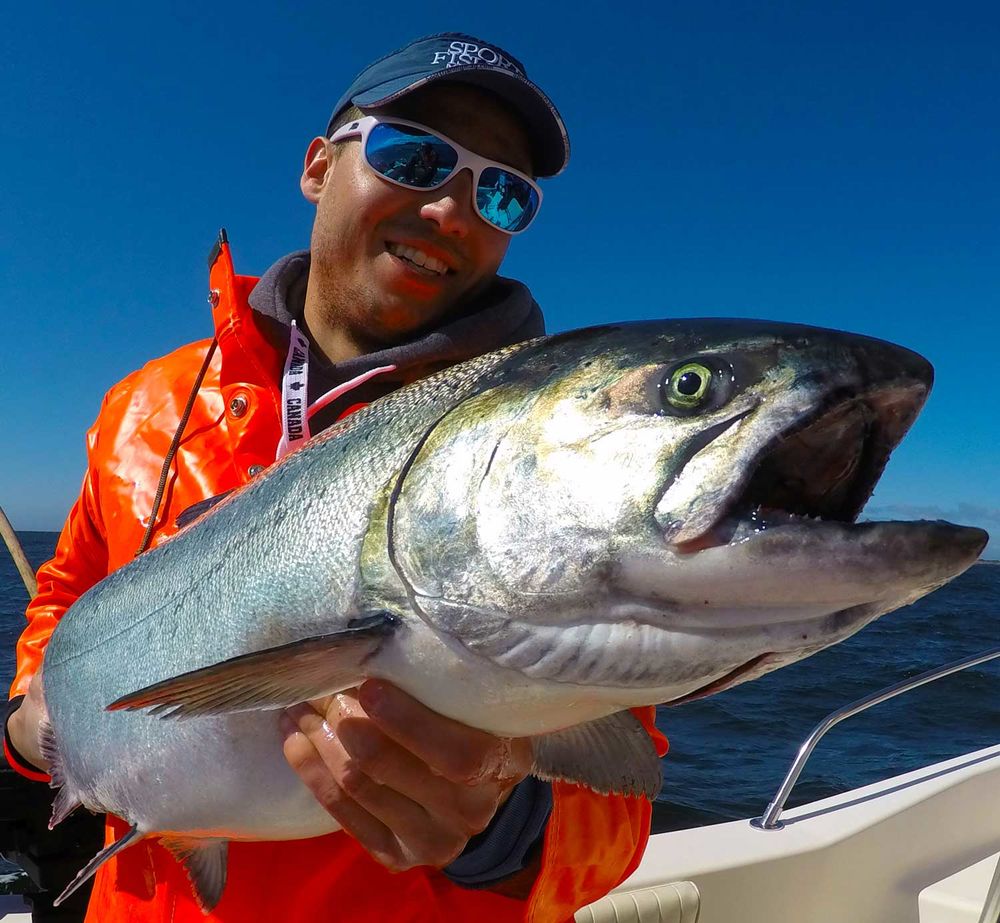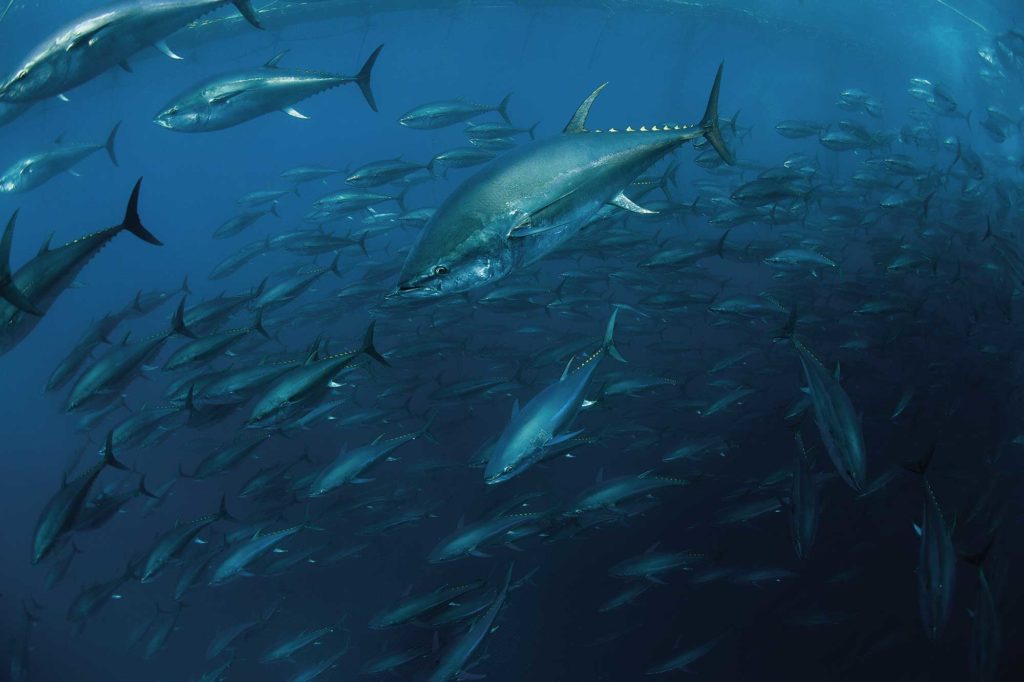
The remarkable story of Southern California’s 2015 and ’16 bluefin tuna seasons unfolds in chapters, each revealing new twists in tackle and techniques — methods that constantly evolved as schools of large, powerful Pacific bluefin roamed off the coast, adopting new feeding habits, becoming increasingly wary and growing to nearly 300 pounds.
From run‑and‑gun‑style fishing to trolling with kites, from casting poppers and jigs to live-baiting with mackerel and squid, tactics and gear changed rapidly.

Perhaps most important, this story might not be over, as reports at press time indicate the schools of big tuna are still around, having wintered far offshore. Lessons learned over the past two years could pay dividends as anglers get another chance to target the fish of a lifetime if and when these tuna move closer to the coast. To set the facts straight, neither 2015 nor 2016 was the best year on record when it came to numbers of Pacific bluefin tuna caught by California recreational anglers. In 2013, for example, passenger boats reported landing 63,702 fish, according to records maintained by the California Department of Fish and Wildlife. However, keep in mind that most of the fish in 2013 were less than 50 pounds and fairly easy to land, and there was a 10-fish daily bag limit. In addition, the CDFW records do not include private‑boat catches.

In 2015, the first year of the state’s two-fish daily per person limit for bluefin tuna, a reported 21,345 bluefin were caught, and in 2016 it was down to 9,306 fish. Yet the 2016 season set the benchmark for size. “The bluefin tuna fishery was off the charts for quality,” says Steve Crooke, a retired marine biologist with the CDFW. “The size of the fish definitely affects the numbers of fish that are landed.”
The loss rate was high. Many anglers were undergunned and ill-prepared for the size of these tuna. Crooke himself went zero for four on big bluefin one day last September while fishing aboard the party boat Cortez at Desperation Reef off the east end of San Clemente Island.
Private-boat anglers have an advantage over the passenger-boat fleet when it comes to landing big tuna. With a private boat, you can chase the fish and use boat-handling techniques to land it more quickly versus a stationary boat full of other anglers.
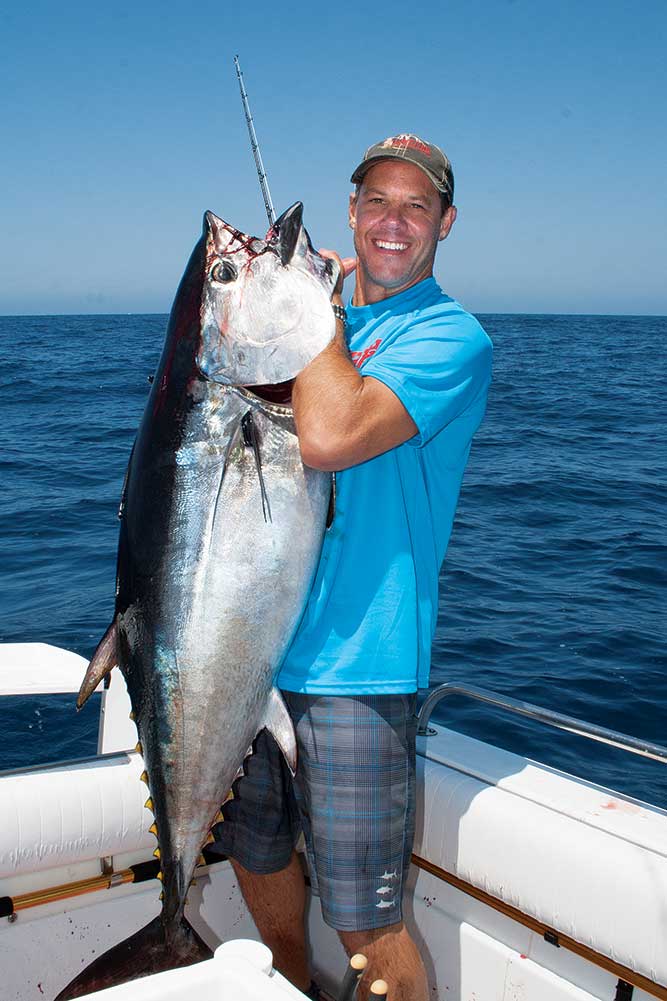
Great Bluefin Tuna Fishing Started in 2015
The big-bluefin bonanza began in May 2015, with schools found between the coast and San Clemente Island. Good fishing carried through December for anglers who ventured out to distant banks — Cortez (about 110 miles from Point Loma) and Tanner (about 120 miles from Point Loma). Rough weather in late winter and early spring eventually kept anglers away from the fish, so effectively tracking the schools became nearly impossible.
Anglers rediscovered the fish in June 2016 around the offshore banks just below the Mexican border. But they soon swung up the coast. By late July, the bluefin were within easy reach of ports such as San Diego Bay, Mission Bay, Oceanside Harbor, Dana Point Harbor, Long Beach Harbor and even Marina del Rey.
In June, 50- to 80-pounders were the norm. But by July, many fish broke the century mark. Later in the summer, 200-pound-plus fish began to show. By fall, anglers were landing fish nearing 300 pounds.
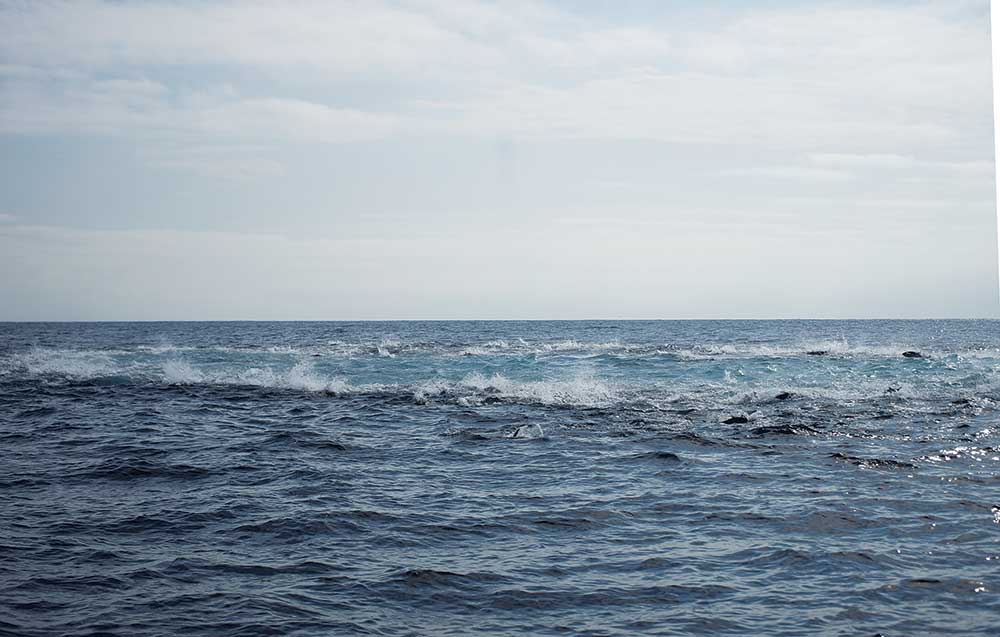
On many days, the waters were literally bursting with bluefin. Huge schools churned the water into an acre or more of roaring foam, annihilating densely packed baitballs, then sinking away, leaving the surface water a milky turquoise and glittering with scales of the departed prey.
“When you see those ‘foamers,’ it’s one of the most exciting forms of fishing you can experience,” says Ben Secrest, vice president of marketing for Accurate Fishing Products. Secrest and Accurate owner David Nilsen joined me aboard my boat in late July, and we found those rampaging schools. We landed a 100-pounder, but lost a bigger tuna when the fish chewed through the 60-pound fluorocarbon leader. That was just the start last year for Team Accurate, which scored several big bluefin, including a season-best 274-pounder.
To the delight of anglers, these schools of Pacific bluefin tuna stayed fairly close to the Southern California coast from midsummer into early winter. This is the story of last year and what experts forecast for the season ahead.
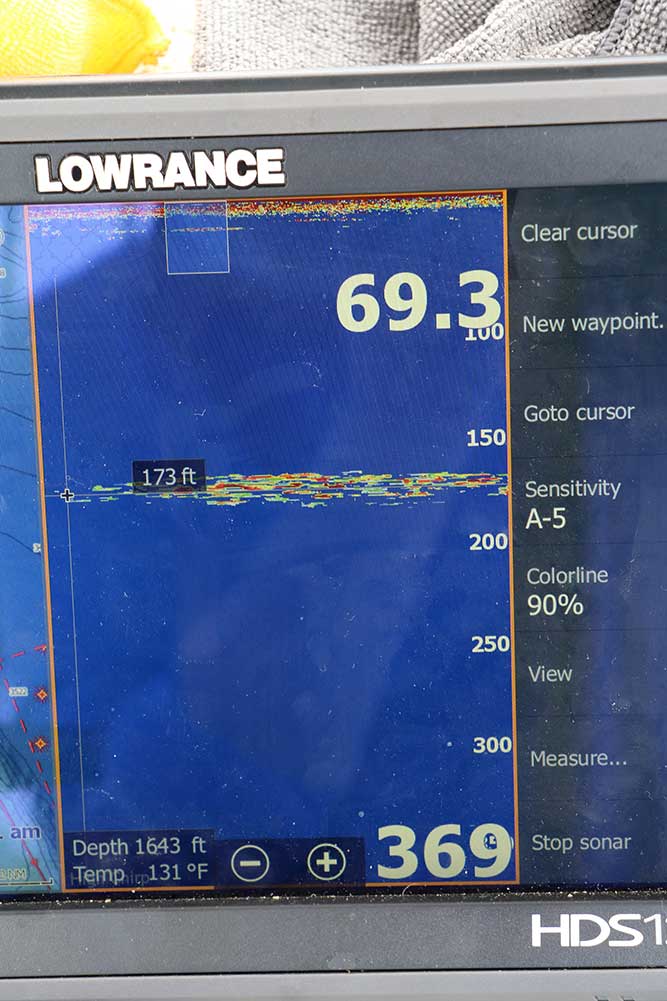
High Numbers of Bluefin Tuna
Although the number of fish anglers have been able to land is down from previous years, the sheer volume of Pacific bluefin tuna off the coast of Southern California seems to defy science. Conservation organizations warn of dwindling stocks, and the Center for Biological Diversity has petitioned to declare the Pacific bluefin tuna an endangered species, but Southern California anglers have seen more of these fish than anyone can recall.
“We saw quite a few schools of bluefin tuna, many more than we have observed in the past,” says Chugey Sepulveda, Ph.D., director and senior scientist for the Pfleger Institute of Environmental Research in Oceanside, California.
“I wouldn’t be surprised if these fish are 40 to 50 pounds heavier than they were last year.”
Sepulveda is careful to qualify his statement. “From our perspective, it’s difficult to know how many were here as we only observe surface fish and several schools are observed more than once,” he adds. “Thankfully, the schools stuck around and gave everyone a great season.”
Indeed, many anglers who had never previously caught bluefin were bringing in a big fish or two. Perennial high-liners, such as Greg Stotesbury, national sales manager for AFTCO, enjoyed immense success. In 2015, Stotesbury and crew caught 30 bluefin up to 131 pounds, and in 2016, that number grew to 40 fish up to 205 pounds.
More Red Crabs Equals More Bluefin Tuna
Conventional scientific thinking held that this population of bluefin tuna typically migrated in a counterclockwise rotational pattern around the North Pacific, moving up the West Coast of North America and across to Japan, eventually circling back to North America.
Yet, these fish seem to have taken up residence off the southern coast of the Golden State. What’s holding them here? Two words: red crabs.
The bluefin schools seem to aggregate in areas that have moderate to heavy red crab density, according to Sepulveda. A super abundance of these pelagic crustaceans (also known as tuna crabs) appears to have provided a steady food supply.
What brings the red crabs to this coast is anyone’s guess, but these mini-lobsterlike creatures form massive schools that can stretch for miles, marking so distinctly on fish finders that the shoals of biomass look like the ocean floor.
Sometimes the crabs wash ashore, blanketing beaches and clogging harbors. More often you find them offshore, hovering anywhere from the surface down to the thermocline, and there’s no doubt that bluefin feed heavily upon them.
“We’ve cut open the stomachs of bluefin we’ve caught and found them jammed with half-digested red crabs,” says Dave Pfeiffer, president and CEO at Shimano America.
That’s not to say that bluefin feed exclusively on red crabs. To the contrary, anglers have hooked them on a wide range of baits and lures — and virtually none on red crabs — but the crabs seem to be providing the staple diet that keeps the tuna from leaving.
How to Find Bluefin Tuna
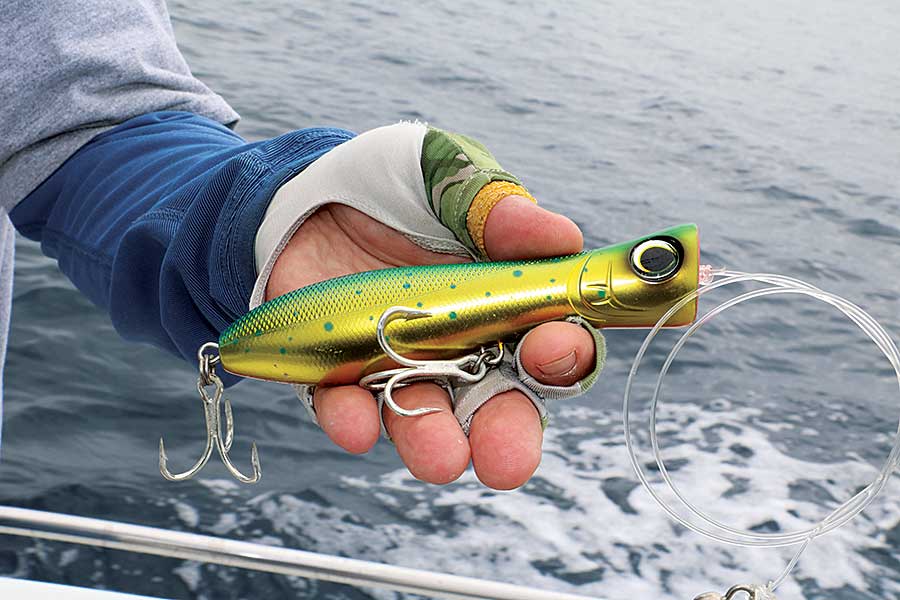
Much of the June and July action consisted of scouting for signs of surface fish, including fluttering and dipping terns, all-out foamers and so-called “breezers” — schools of bluefin pushing wakes and flashing their silvery flanks while cruising near the surface. The goal is to intercept a school and cast lures to the fish.
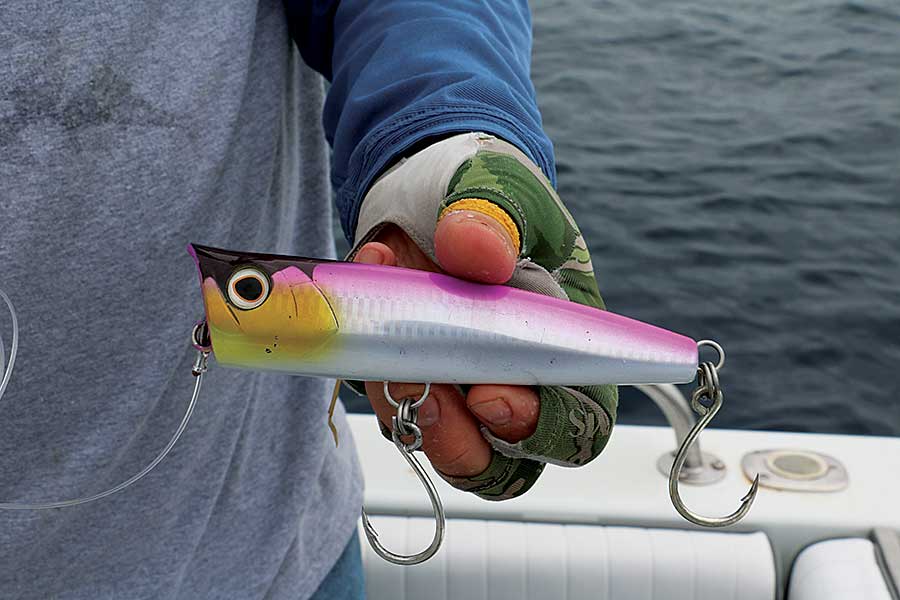
It was in this scenario that Nilsen, Secrest and I found ourselves last July. By 9 a.m. we had found several schools of crashing tuna about 30 miles off Dana Point. We had tied on poppers such as the Shimano Pop Orca, Williamson Popper Pro and Yo-Zuri Big Game Bull Popper as many fish had been caught on these surface baits in the days and weeks earlier. But this day, the tuna seemed to ignore them.

These tuna were feeding on schools of 3-inch-long anchovies, so Secrest suggested we switch to small metal jigs such as Ahi Deception, Megabait, Magic Metals and the Shimano Colt Sniper. Soon after the switch, we intercepted a crashing school of tuna and Nilsen hooked up on his first cast across the foaming fish.
Long casts are critical in this style of fishing. Although serious Southern California saltwater anglers have long resisted spinning gear, many now see the virtue of spinning reels with matching rods for casting small, light jigs and poppers to groups of tuna.
“It’s important to cast the lure past the school and then work it back through them,” Pfeiffer says. “That requires a long, accurate cast. An optimized spinning outfit is the best tool for throwing a relatively light lure a long distance.”
One such combination is a Shimano Stella 14000 or 18000 saltwater spinning reel with a rod such as a Shimano Terez 78XH, says Pfeiffer, who loads the reel with 65- to 80-pound PowerPro braided line and 80- to 100-pound fluorocarbon leader. Stella reels possess powerful drags, and the 7-foot-8-inch Terez offers plenty of lifting power for battling a 200-plus-pound bluefin. Adding an AFTCO Spin Strap lets you use a harness for added leverage when battling such powerful fish with spinning gear.
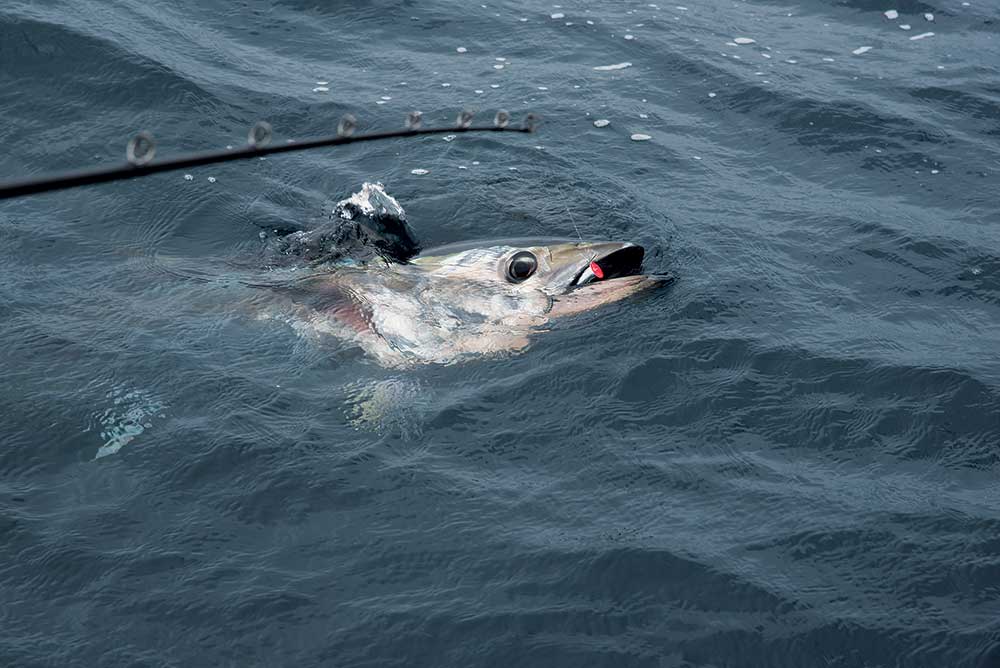
How to Approach a School of Bluefin Tuna
One lesson learned by savvy anglers during the run-and-gun phase of this fishery is that stealth and patience are critical factors to success. Although fast boats offer an advantage in chasing schools of fish, too many throttle jockeys charge in hot and put down the fish before they even have a chance to cast, says Secrest. “Rather than charging at the school, try to circle around well upwind of the fish and shut down the motor, then wait for them to come to you,” says Secrest. “It doesn’t always work, but often you become part of the environment and, if you’re lucky, the feeding bluefin will come right to the boat.”
Pfeiffer echoes that advice, but adds: “Whatever you, do not put a wake across the fish; that will put them down for sure.”
Pfeiffer prefers a slow, patient approach to the fish. “Sometime we just follow the school at a distance and try to figure out where they are going,” he explains. That gives Pfeiffer a better idea where to intercept the school for casting poppers or metal jigs to the fish.

Also, it doesn’t always pay to cast directly into rampaging fish, says Stotesbury. “Look out ahead of the school for terns, as these birds are often hovering over the leading edge of the fish.” Casting to the lead fish will often buy a strike when the foaming fish ignore your lure, Stotesbury says.
Slow presentations can be effective, especially with poppers, says Pfeiffer. “Many anglers work the popper too fast,” he says. “We work them slow.” If the school sinks away in the middle of the retrieve, stop altogether, Pfeiffer advises, as the tuna might still be circling below, picking off morsels. “Sometimes they will roll up and suck down the stationary popper, thinking it is a wounded bait,” he says.
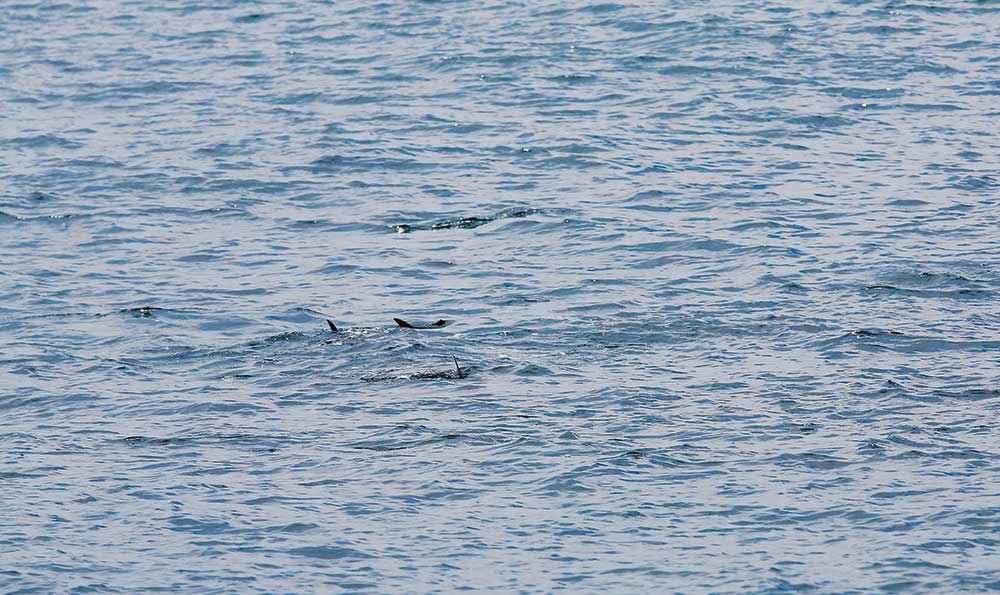
Slow-Trolling Live Bait for Bluefin Tuna
When bluefin are in breezer mode or the foamers prove skittish, slow-trolling a live bait, such as a Pacific mackerel, well behind the boat can pay off, says Stotesbury. “Put the bait way back — 200 feet or more behind the boat — then bump the engine in and out of gear as you try to pull the bait through the school,” he explains. “If you can slow-troll through a group of breezing fish, they will often bite.” Stotesbury says that slow-trolling with outriggers helps keep the baits out of the prop wash.
Although other types of bait worked last year, live opalescent squid became especially effective later in the season when the tuna took up residence off San Clemente Island, particularly around Desperation Reef. Schools of squid had moved into Pyramid Cove at the east end of the island, so the bluefin keyed in on these.
One trick that proved effective: Chum with squid once you spot fish on the surface or mark a school on the fish finder, says Stotesbury. “We would toss out a dipper (netful) of live squid and then put our baits (live squid) out and drift fish with no weight,” he says. The key is to keep the hooked bait out with chum baits and then wait for the fish to circle back or rise from the depths to feed, he says.
When the bluefin seemed to be feeding deep in the water column, fishing live squid on dropper loops set five to 10 cranks off the bottom also scored a number of big bluefin. While several of the passenger fishing boats anchored to fish around San Clemente, drift-fishing with squid was a go-to method for many private boaters, giving them the freedom to give chase once they hooked a big fish.
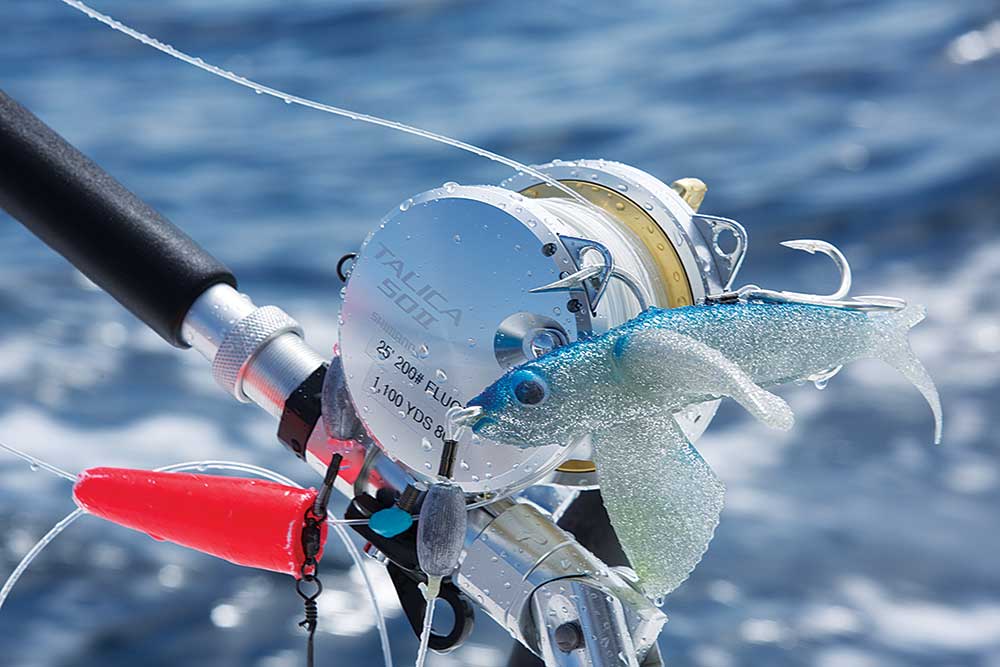
Kite-Fishing Results in Big Bluefin Tuna Catches
Few anglers realize that kite-fishing — indeed big-game fishing — was born in Southern California ocean waters, pioneered by members of the 119-year-old Tuna Club of Avalon on Santa Catalina Island.
The technique made a big comeback in 2015 and ’16 as many Southern California boating anglers purchased kites from brands such as AFTCO and Boston Big Game Fishing Club to troll a flying-fish imitation known as a Yummy Flyer. This also resulted in some of the biggest bluefin tuna catches last season, as it allowed anglers to fish heavier trolling tackle using reels such as an Accurate ATD Platinum 50W or 80 with a matching rod.
“You need to fly a single kite way back, about 150 yards behind the boat, while trolling 9 to 11 knots, depending on conditions,” Secrest says. “You want to troll with the wind on your beam to help keep the kite out to one side and away from the prop wash.”
As with most forms of kite-fishing, you must constantly watch the lure and make adjustments to keep the Yummy Flyer skipping on the surface, as would an actual flying fish. Once a bluefin strikes, it is important to get tight on the fish immediately to trigger the release clip and ensure a good hook-set.
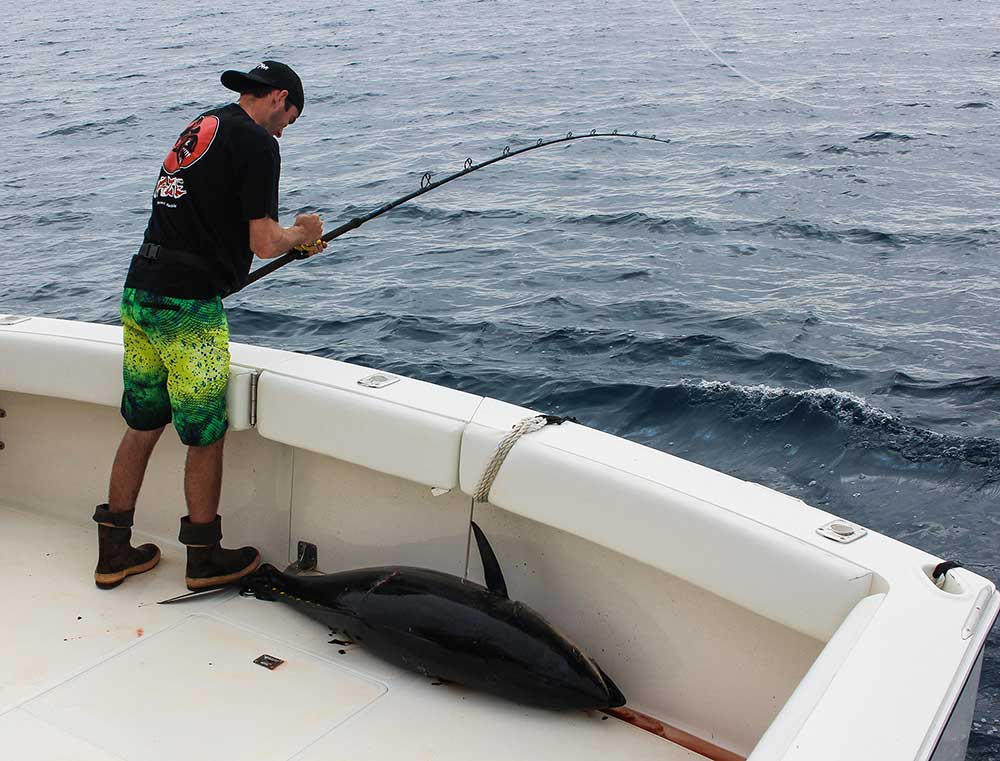
California’s Bluefin Tuna Season in 2017
As of this writing, the 2017 Pacific bluefin tuna season already seems to be taking shape. “Commercial spotter planes are seeing schools of fish between the west end of San Clemente Island and the Tanner Bank,” says Crooke. “These are larger models. I wouldn’t be surprised if these fish are 40 to 50 pounds heavier than they were last year.”
Such reports have turned anglers antsy with anticipation of foaming tuna. It seems that more chapters have yet to be added to this remarkable story of Southern California’s big bluefin bonanza.
For more travel stories from Sport Fishing, check out the one below on the incredible fishing of a remote island northern Vancouver.
